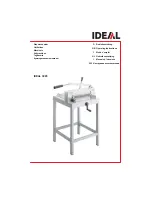
EN
PCT50
916.400.139_002
49
6.3.5
Spreading
Initial opening is sufficient
•
Close the blades completely.
•
Put both blade tips between the parts to be spread.
•
Put the load 25 mm from the end of the tips. Use full width of the tips.
•
Force the parts apart by opening the blades.
Initial opening is insufficient
•
Open the blades.
•
Put one blade tip in the opening. Use full width of the tip.
•
Close the blades until the material is clamped.
•
Bend the clamped material out of the way.
•
Repeat this procedure until there is sufficient space to place both blade tips.
•
Force the parts apart by opening the blades.
No initial opening
•
Use a different tool or accessory to make an opening.
•
Continue with the steps above, depending on the opening created.
6.3.6
Pulling
•
Fully open the blades.
•
Make sure the openings of the shortening hooks do not point down.
•
Attach the pulling chains to the objects so that they cannot slip off.
•
Pull the chains tight and hook them to the pulling attachments.
•
Close the blades.
6.3.7
Maximum force indicator
Refer to 3.4, 2.
CAUTION
Always use the spreading tips. Make sure the lock pins stay locked.
NOTICE
Not all tools have been designed for pulling. See section 3.10.2 for the tools that can be
used for pulling.
WARNING
The pulling accessories are intended solely for the horizontal movement of loads.
Make sure the lock pins stay locked.
Hoisting is not permitted with these accessories.
WARNING
Make sure that the load is always supported from underneath. Continuously check the
behaviour of the load. Make sure that the tool can move freely during pulling and always
remains in a straight line between both pulling attachments.
Summary of Contents for PCT50
Page 1: ...i PCT50 Handleiding NL Manual EN Mode d emploi FR Betriebsanleitung DE Manual ES Manual PT ZH...
Page 3: ...PCT50 916 400 139_002 3 Fig 1 Fig 2...
Page 4: ...4 916 400 139_002 PCT50 Fig 3 Fig 4 Fig 5 Fig 6 Fig 7 Fig 8...
Page 168: ...ZH 168 916 400 139_002 PCT50 1 1 1 1 2 1 3 i 1 4 1 5 Pentheon 1 5 1 1 6 1 7...
Page 169: ...ZH PCT50 916 400 139_002 169 1 8 CE 2 2 1 2 2 Fig 1...
Page 170: ...ZH 170 916 400 139_002 PCT50 i Pos A CE B 921 000 084...
Page 171: ...ZH PCT50 916 400 139_002 171 2 3 2 4 2 5 Fig 12...
Page 172: ...ZH 172 916 400 139_002 PCT50 2 6 2 7 2 8 5 2 30 1 40 C 104 F...
Page 173: ...ZH PCT50 916 400 139_002 173 3 Fig 5 2 9 2 10 EN ISO 12100 2 11...
Page 181: ...ZH PCT50 916 400 139_002 181 5 5 on off LED LED LED 5 6 i 5 7 LED LED 6 6 1 10 on off LED...
Page 183: ...ZH PCT50 916 400 139_002 183 Fig 8 A B C 6 3 4 25mm 6 3 5 25mm Fig 13...
Page 184: ...ZH 184 916 400 139_002 PCT50 6 3 6 6 3 7 3 4 2 6 3 8 6 4 6 4 1 3 6 2 6 4 2 3 10 2...
Page 190: ...ZH 190 916 400 139_002 PCT50 45 C 113 F 9 Fig 14 NBR 3 WEEE 2012 19 EU RoHS 2011 65 EU...
Page 191: ...191 916 400 139_002 i Fig 9 Fig 10...
Page 192: ...192 916 400 139_002 PCT50 i Fig 11 Fig 12 Fig 13 Fig 14 90...
















































